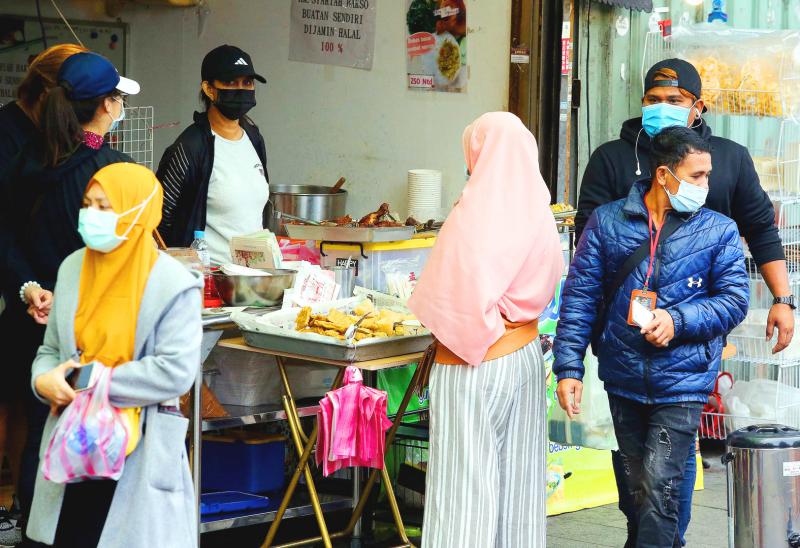The Central Epidemic Command Center (CECC) yesterday reported three cases of COVID-19, all Indonesians, while saying that it is considering whether Indonesian migrant workers should be conditionally granted entry into Taiwan again.
Centers for Disease Control Deputy Director-General Chuang Jen-hsiang (莊人祥), the CECC’s spokesman, said that case No. 735 is a man in his 20s, who came to work as a ship crew member on Nov. 24, and he provided a negative polymerase chain reaction (PCR) test result from within three days of his flight to Taiwan.
The man did not have any symptoms, but tested positive in a paid test on Thursday after ending quarantine at a hotel, Chuang told a news conference.

Photo: CNA
The second case, a migrant worker in her 20s, arrived on Nov. 28, provided a negative PCR test result, tested negative again in an extended testing project on Dec. 4, but she experienced bloating and vomiting on Thursday, Chuang said.
The woman — case No. 736 — was tested on Friday before completing centralized quarantine, and the result came back positive, with a low cycle threshold value (CT-value) of 27, indicating a recent infection, he said.
The third case is a migrant worker in her 30s, who came to Taiwan on Nov. 25 and tested negative on Nov. 23, but did not provide the report, he said.
Chuang said that the woman — case No. 737 — did not have any symptoms and tested negative twice on Nov. 28 and on Tuesday while in centralized quarantine, but she later tested positive in a paid test on Thursday.
Asked if the CECC is capable of verifying the authenticity of foreign PCR test result reports, Chuang said that it would work toward asking the representative office in Indonesia to find several testing facilities certified by the local authority, and require migrant workers to provide test reports from them.
Other than the possibility of inauthentic test reports, there are also two reasons why some arriving travelers could have provided a negative PCR report, but still tested positive in Taiwan, he said.
They could have been tested during the incubation period, which is likely in case No. 736; or the person could have been infected for a long period of time and have a low viral load, so some tests might come back negative and some positive, which is likely in case No. 737, Chuang said.
Separately, Minister of Health and Welfare Chen Shih-chung (陳時中), who heads the center, was asked about policies for Indonesian migrant workers, who were temporarily banned from entering Taiwan for two weeks, starting on Dec. 4.
Chen said that the government would discuss whether to conditionally reopen the borders for some Indonesian migrant workers, as there is urgent demand for them in the nation.
Chen was also asked to respond to a report by the Chinese-language Liberty Times (the Taipei Times’ sister newspaper) yesterday saying that the 10 million COVID-19 vaccines purchased by the CECC are the Oxford-AstraZeneca vaccine.
Chen said that the center would make an official announcement once the outcome is settled.
The CECC is negotiating with a few vaccine manufacturers and saying too much might be harmful to those negotiations, but the criteria for purchasing vaccines are based on scientific evidence, and specialists would also help determine the vaccines’ efficacy and safety from the clinical trial results, he said.
Chen also urged people not to remove their masks when taking group photographs, jokingly saying that 90 percent of people look better while wearing a mask.

CROSS-STRAIT COLLABORATION: The new KMT chairwoman expressed interest in meeting the Chinese president from the start, but she’ll have to pay to get in Beijing allegedly agreed to let Chinese Nationalist Party (KMT) Chairwoman Cheng Li-wun (鄭麗文) meet with Chinese President Xi Jinping (習近平) around the Lunar New Year holiday next year on three conditions, including that the KMT block Taiwan’s arms purchases, a source said yesterday. Cheng has expressed interest in meeting Xi since she won the KMT’s chairmanship election in October. A source, speaking on condition of anonymity, said a consensus on a meeting was allegedly reached after two KMT vice chairmen visited China’s Taiwan Affairs Office Director Song Tao (宋濤) in China last month. Beijing allegedly gave the KMT three conditions it had to

STAYING ALERT: China this week deployed its largest maritime show of force to date in the region, prompting concern in Taipei and Tokyo, which Beijing has brushed off Deterring conflict over Taiwan is a priority, the White House said in its National Security Strategy published yesterday, which also called on Japan and South Korea to increase their defense spending to help protect the first island chain. Taiwan is strategically positioned between Northeast and Southeast Asia, and provides direct access to the second island chain, with one-third of global shipping passing through the South China Sea, the report said. Given the implications for the US economy, along with Taiwan’s dominance in semiconductors, “deterring a conflict over Taiwan, ideally by preserving military overmatch, is a priority,” it said. However, the strategy also reiterated

‘BALANCE OF POWER’: Hegseth said that the US did not want to ‘strangle’ China, but to ensure that none of Washington’s allies would be vulnerable to military aggression Washington has no intention of changing the “status quo” in the Taiwan Strait, US Secretary of Defense Pete Hegseth said on Saturday, adding that one of the US military’s main priorities is to deter China “through strength, not through confrontation.” Speaking at the annual Reagan National Defense Forum in Simi Valley, California, Hegseth outlined the US Department of Defense’s priorities under US President Donald Trump. “First, defending the US homeland and our hemisphere. Second, deterring China through strength, not confrontation. Third, increased burden sharing for us, allies and partners. And fourth, supercharging the US defense industrial base,” he said. US-China relations under

The Chien Feng IV (勁蜂, Mighty Hornet) loitering munition is on track to enter flight tests next month in connection with potential adoption by Taiwanese and US armed forces, a government source said yesterday. The kamikaze drone, which boasts a range of 1,000km, debuted at the Taipei Aerospace and Defense Technology Exhibition in September, the official said on condition of anonymity. The Chungshan Institute of Science and Technology and US-based Kratos Defense jointly developed the platform by leveraging the engine and airframe of the latter’s MQM-178 Firejet target drone, they said. The uncrewed aerial vehicle is designed to utilize an artificial intelligence computer